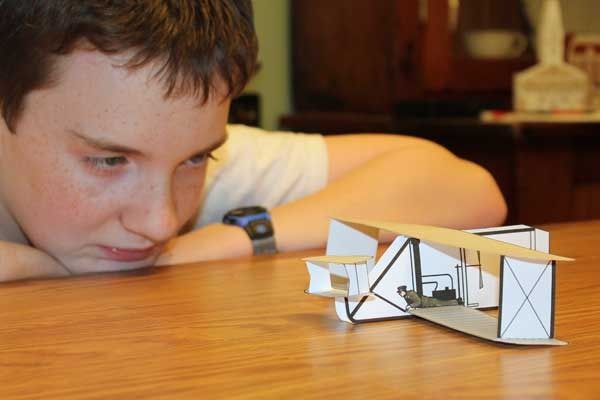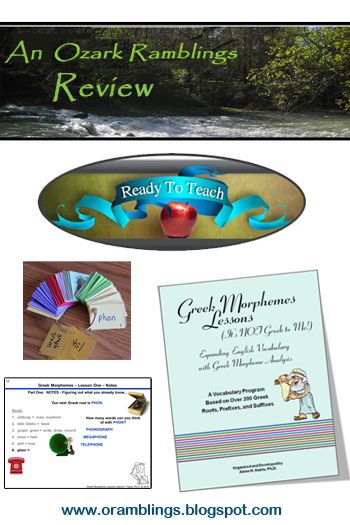 Those of you familiar with the movie or musical versions of Mary Poppins know that when one wants to make an impression, they say "Supercalifragilisticexpialidocious" (actress Julie Andrews even knows how to say it backwards, which is doubly impressive). Lately in our home we’ve found our own favorite lengthy word~~ microarchaegynophobia. This is all thanks to a company called Ready to Teach. We’ve been building our vocabulary for the last few weeks with their curriculum Greek Morphemes Lessons (It's NOT Greek to Me!).
Those of you familiar with the movie or musical versions of Mary Poppins know that when one wants to make an impression, they say "Supercalifragilisticexpialidocious" (actress Julie Andrews even knows how to say it backwards, which is doubly impressive). Lately in our home we’ve found our own favorite lengthy word~~ microarchaegynophobia. This is all thanks to a company called Ready to Teach. We’ve been building our vocabulary for the last few weeks with their curriculum Greek Morphemes Lessons (It's NOT Greek to Me!).
We should probably start with a definition for “morpheme.” According to dictionary.com it refers to:
N. any of the minimal grammatical units of a language, each constituting a word or meaningful part of a word, that cannot be divided into smaller independent grammatical parts
While you may not know the term, you’re probably familiar with the concept from school days, namely roots, prefixes, and suffixes. In our case they’re all coming from the Greek language. Let’s go back and look at our new favorite word broken down into its morphemes.
- MICRO~~small
- ARCHAE~~ancient
- GYN~~women
- PHOPIA~~a fear of
In other words, microarchaegynophobia is a fear of little old ladies.
For this review we received a Student Book and an Instructor’s Manual. In the back of the Instructor’s Manual is a CD-rom with PowerPoint presentations for each lesson, quizzes, and templates for transparencies if you would want to use an overhead projector in a classroom setting (I suppose you could print them out as posters for your homeschool room). In the future, buyers will receive these digital files on a flash drive.
The course is divided into 12 lessons, each containing 12-22 morphemes: roots, prefixes and suffixes. What I appreciated was the exposure over and over to each morpheme—by the end of the the lesson, you almost couldn’t help having them memorized.The Instructors Manual shows how to cover the lesson in five days, but this is a writing intensive curriculum (my son’s least favorite activity). We actually divided it into shorter lessons for more days. Let’s use the morpheme “phon” as an example…
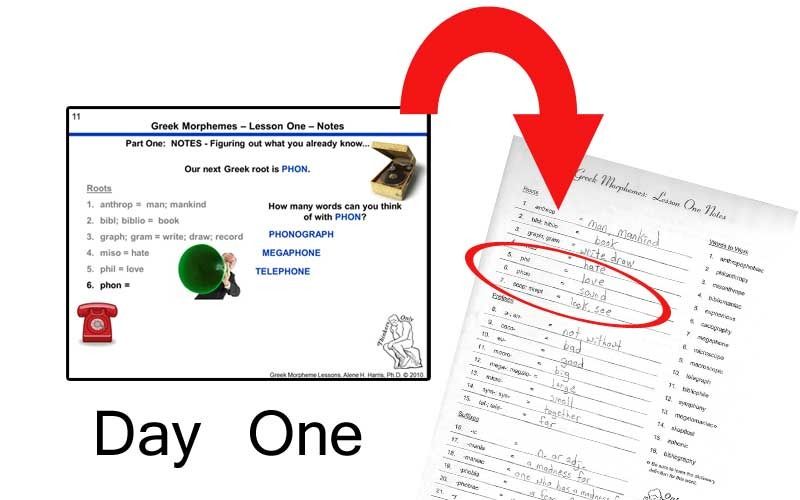 Day 1
Day 1
Schnickelfritz watches the PowerPoint presentation. It begins by giving samples of words containing the morpheme to see if the student can deduce the meaning. After each definition has been revealed, he will write it down in the student book. Be sure to view this as a slide presentation so pictures pop up and words slide into place. If you just look at each slide on it’s own the page can look jumbled up.
Day 2
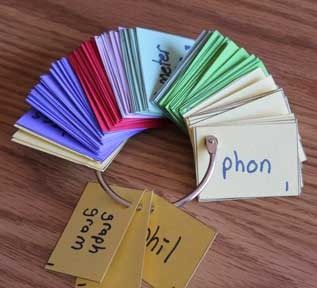 We would make Study Cards for each morpheme. The manual saves this task for the end of the lesson, but I let Fritz use his cards for Days 3-7. We’d write the morpheme on one side and the definition on the other. The back of the Student Book contains colored sheets of paper for this purpose. If I could make one suggestion to the folks at Ready To Teach I’d ask them to make these sheets of heavier paper, like cardstock. The cards are designed to be cut out and hole-punched to store on a key ring and the flimsy paper easily tears. I ended up raiding my supply of cardstock for lapbooks to make sturdier cards. The Instructor’s Manual does contain cardstock versions of the Study Cards, but rather than colored paper the words are printed in different colors on all white stock. I chose to let Fritz make his own since this was another review opportunity.
We would make Study Cards for each morpheme. The manual saves this task for the end of the lesson, but I let Fritz use his cards for Days 3-7. We’d write the morpheme on one side and the definition on the other. The back of the Student Book contains colored sheets of paper for this purpose. If I could make one suggestion to the folks at Ready To Teach I’d ask them to make these sheets of heavier paper, like cardstock. The cards are designed to be cut out and hole-punched to store on a key ring and the flimsy paper easily tears. I ended up raiding my supply of cardstock for lapbooks to make sturdier cards. The Instructor’s Manual does contain cardstock versions of the Study Cards, but rather than colored paper the words are printed in different colors on all white stock. I chose to let Fritz make his own since this was another review opportunity.
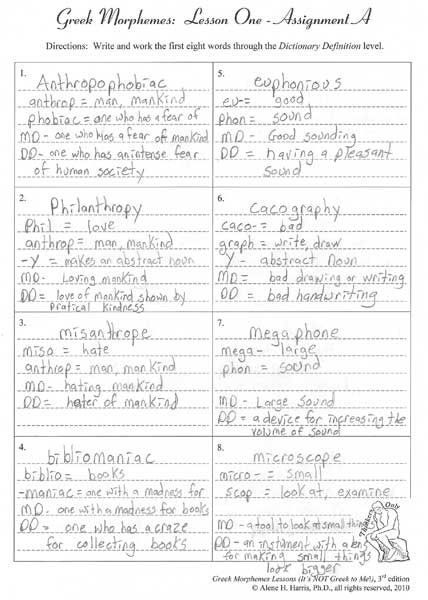 Days 3 and 4
Days 3 and 4
Each day we were given eight words to work. First we’d deconstruct the word into its morphemes and write the definition for each. Then my son would write “my definition” (MD) of the word based on his interpretation of the morphemes. Finally comes the dictionary definition (DD) that we either look up in the dictionary or I supply from the Instructor’s Manual. Some of the words to work will have an asterisk, meaning it’s important to learn the dictionary definition e.g. “megalomaniac” should mean one who has a madness for large things based on its morphemes, but in reality it’s come to mean one who has delusions of great personal power. Sometimes it was hard to fit everything in the space provided, especially if there were three morphemes in the word or the dictionary definition was long.
Day 5
We pick any eight of the sixteen words worked before and write a sentence containing the word, but also giving clues as to its meaning. We could include synonyms or antonyms, examples, or even the definition itself. Scnhickelfritz chose to write “My friend and I like to go to the symphony to hear all the musicians playing together” Writing these context sentences was the most difficult part of the lesson for him—having to write and think up original thoughts that still met the expectations of the assignment. He did like the end of the day where he could create two of his own words by combining morphemes. Today, both words used our sample, “phon.”
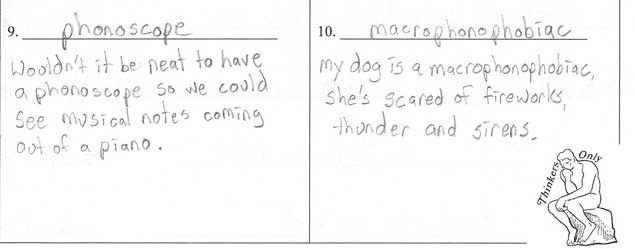
Day 6
Another day with large words to break down and define. This time they gave us far less room to write in the morpheme definitions.
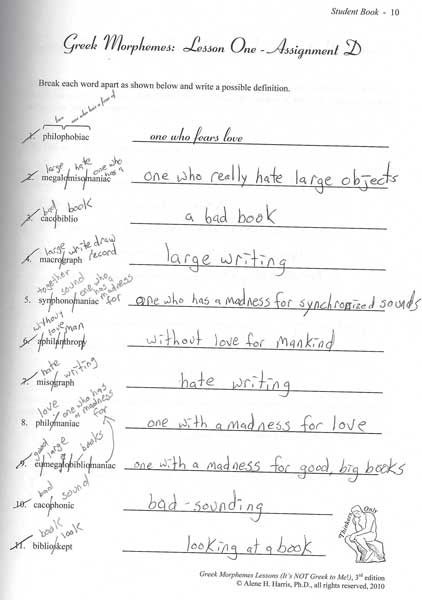
Day 7
Next to making up his own words, this days worksheet provided the most entertainment. We had to match some silly definitions with Day Six’s words. For example “this person would not collect elephants” would be matched up with the word “megalomisomaniac” (large + hate + one who has a madness for). Two words would be left over and my son would have to come up with his own definitions.
SYPMHONOMANIAC~~someone who listens to the TV and radio at the same time
PHILOMANIAC~~this person goes crazy for Valentine’s Day
DAY 8
The study cards are put away for the quiz. This is done through PowerPoint as well. After selecting one of the answers in the column a new slide will appear with “Good Job” or “Try Again.”
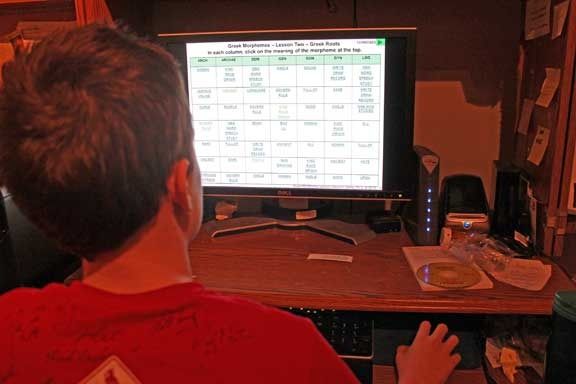
Did you count how many times my son covered the “phon” morpheme? It had to be over a dozen times, and that doesn’t include pure review with the study cards. And after the lesson, things aren’t just flushed away to make room for the new. After several lessons you’ll find an all-encompassing review (Lessons 1-2, Lessons 1-6, and Lessons 7-12). I have to believe this mastery approach will really stick with him (and I have tested him with pop quizzes to prove it).
I know a strong vocabulary will help my son go far—it’s an important component of the college entrance exams, it helps him to read complex works of literature, it may impress a future employer during an interview. By learning these 200+ morphemes he’ll actually be able to deduce the meanings of thousands of words! When we complete this course I think it will be well worth our time to continue through their Latin Morpheme study.



 The Tempest
The Tempest Spring is just around the corner and that can mean a lot of different things to different people. My neighbor has already rototilled his garden plat in anticipation for getting his hands in the dirt. A lot of the country is just ready for the temperatures to rise and the snow to melt. For me spring means I get to go to Homeschool Expo.
Spring is just around the corner and that can mean a lot of different things to different people. My neighbor has already rototilled his garden plat in anticipation for getting his hands in the dirt. A lot of the country is just ready for the temperatures to rise and the snow to melt. For me spring means I get to go to Homeschool Expo. 
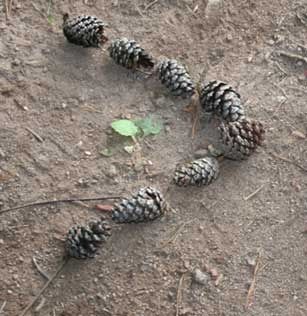
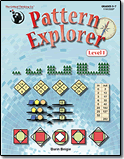 so you could find your way OUT of the woods. We see patterns in the night sky—the constellations and the non-moving North Star help us navigate while the repeating phases of the moon help us track the passage of time. The planet Neptune was discovered when scientists recognized something out there was causing Uranus to deviate from its predicted pattern of orbiting the sun. All in all, I would say being able to recognized a pattern is fairly important.
so you could find your way OUT of the woods. We see patterns in the night sky—the constellations and the non-moving North Star help us navigate while the repeating phases of the moon help us track the passage of time. The planet Neptune was discovered when scientists recognized something out there was causing Uranus to deviate from its predicted pattern of orbiting the sun. All in all, I would say being able to recognized a pattern is fairly important.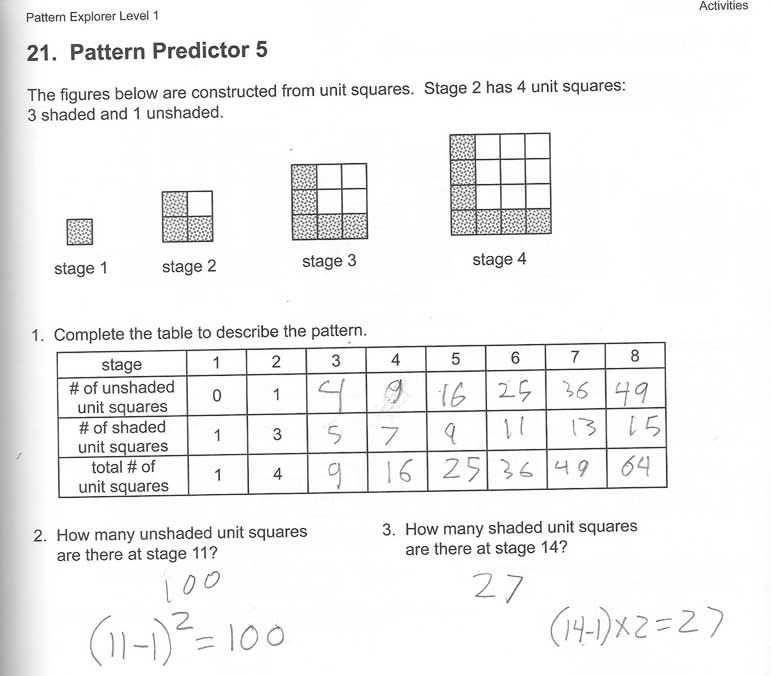
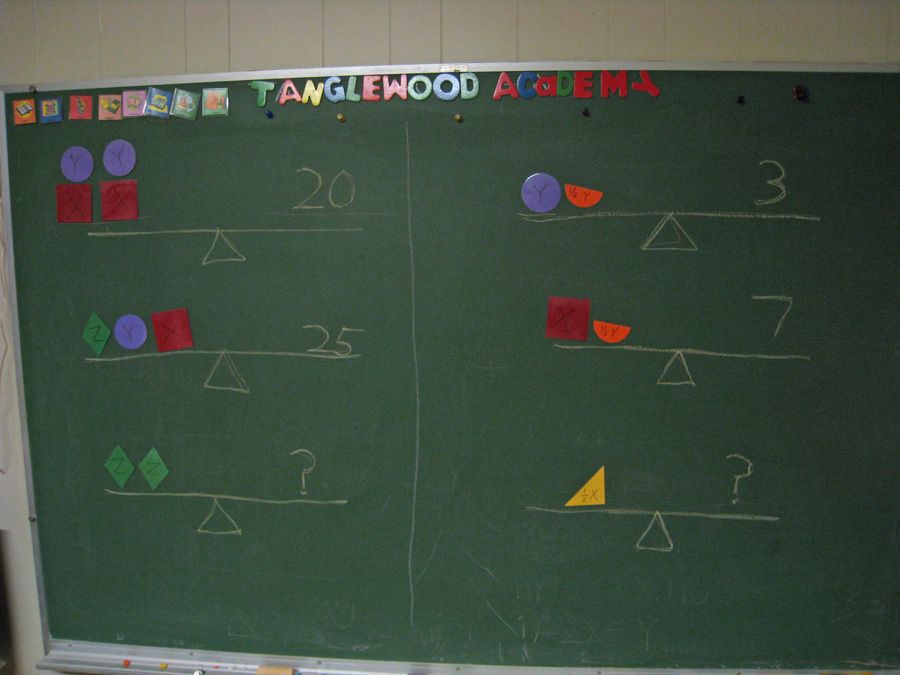
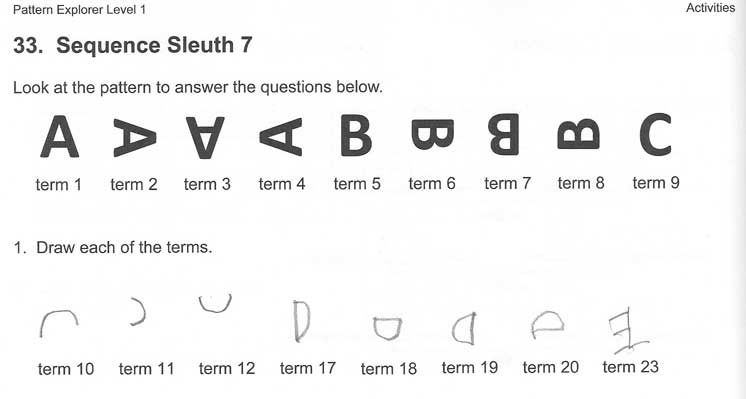
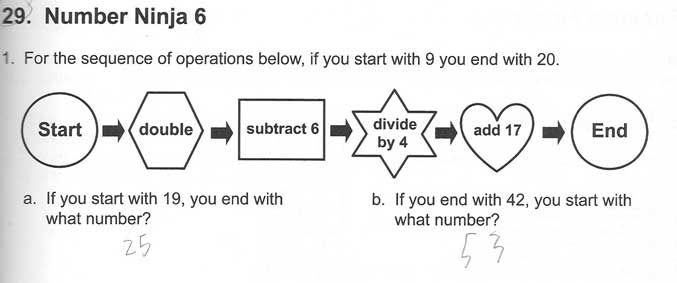
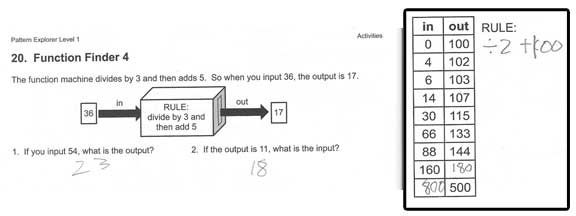
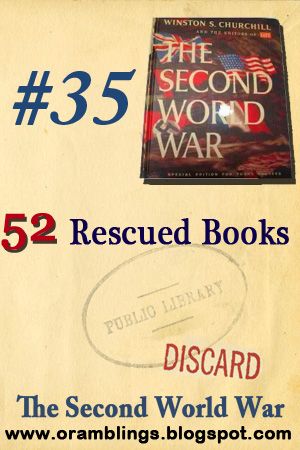 The Second World War. Churchill, Winston S. & Editors of Life. New York: Golden, 1960. 384pp.
The Second World War. Churchill, Winston S. & Editors of Life. New York: Golden, 1960. 384pp.

 On the next day, back at home, my son and I would go through some of the activities found in the student activity pages. There would always be a vocabulary activity:unscrambling words and matching them with their definitions. Other “paperwork” activities included looking at drawings of vertebrates and writing what class they belonged to, other animals in that class, what environment it could be found in and what its physical feature were. Another time we diagrammed covalent bonds. In other cases we would find instructions for an experiment—in the simple machines lesson we made a lever with a ruler, some dimes, and a pen for the fulcrum. In the compounds in chemistry lesson we tested the pH of a variety of common liquids. We didn’t explore every lesson, but the ones we did only required common materials—no need to place an order with a scientific supply company.
On the next day, back at home, my son and I would go through some of the activities found in the student activity pages. There would always be a vocabulary activity:unscrambling words and matching them with their definitions. Other “paperwork” activities included looking at drawings of vertebrates and writing what class they belonged to, other animals in that class, what environment it could be found in and what its physical feature were. Another time we diagrammed covalent bonds. In other cases we would find instructions for an experiment—in the simple machines lesson we made a lever with a ruler, some dimes, and a pen for the fulcrum. In the compounds in chemistry lesson we tested the pH of a variety of common liquids. We didn’t explore every lesson, but the ones we did only required common materials—no need to place an order with a scientific supply company.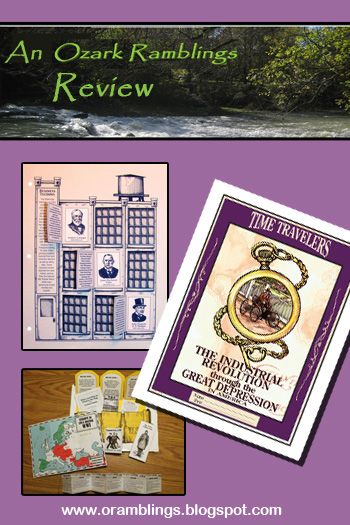 Whenever I get into a conversation about homeschooling with a non-homeschooler for some reason they feel the need to share with me why they’ve chosen the more traditional path. “I could never do that because….” they say, and the reason more often than not is they don’t feel qualified. Let me be candid that I’m not an expert in everything I teach my son. And that’s okay! You’d be amazed at the bonding that can occur when we learn something TOGETHER. Take history for instance…now I’m sure somewhere in my past I learned about the period between the American Civil War and World War II. I took an honors course that combined history with literature and I can remember reading The Jungle, The Great Gatsby, and All Quiet on the Western Front. My memory of the literature is clear, but what happened to the historical facts? The names and places and battles and other events? They were all packed in some dry, dull textbook like sardines and I only held onto them long enough to pass the test and then they were flushed to make way for new material.
Whenever I get into a conversation about homeschooling with a non-homeschooler for some reason they feel the need to share with me why they’ve chosen the more traditional path. “I could never do that because….” they say, and the reason more often than not is they don’t feel qualified. Let me be candid that I’m not an expert in everything I teach my son. And that’s okay! You’d be amazed at the bonding that can occur when we learn something TOGETHER. Take history for instance…now I’m sure somewhere in my past I learned about the period between the American Civil War and World War II. I took an honors course that combined history with literature and I can remember reading The Jungle, The Great Gatsby, and All Quiet on the Western Front. My memory of the literature is clear, but what happened to the historical facts? The names and places and battles and other events? They were all packed in some dry, dull textbook like sardines and I only held onto them long enough to pass the test and then they were flushed to make way for new material.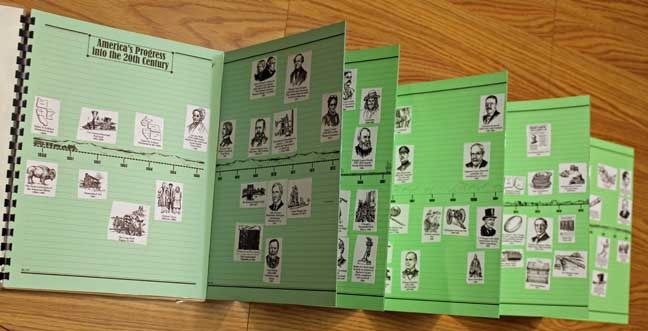
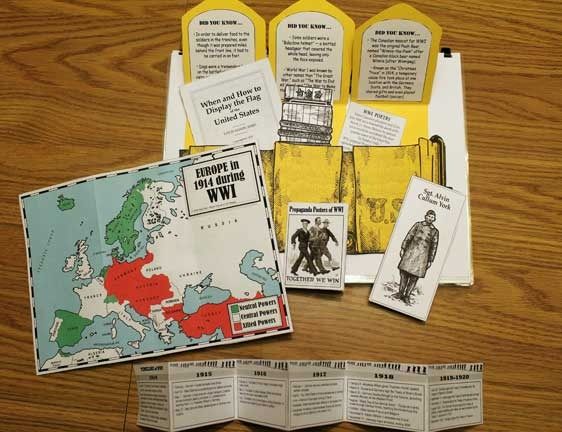
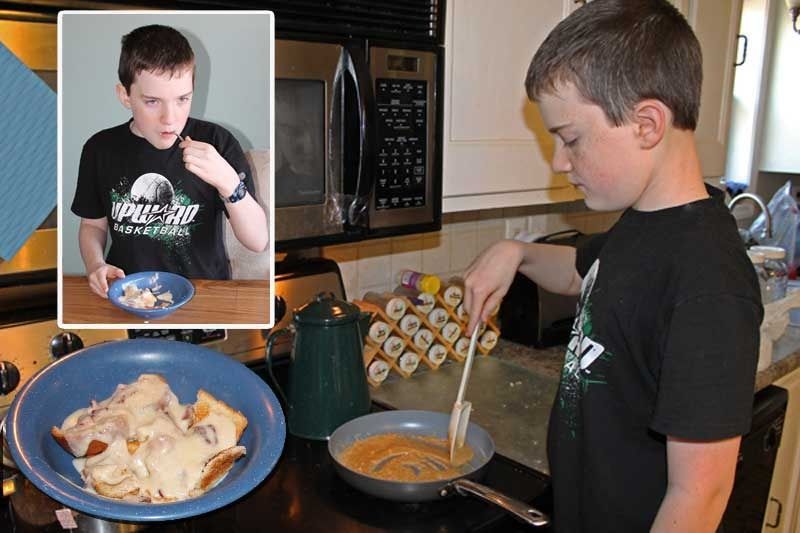 Here’s a picture of my Schnickelfritz making our take on Chipped Beef on Toast—no comments please from those who have served in the military. I say our take because I couldn’t actually find chipped beef in our rural mom & pop grocery store so we used a strip of beef jerky (found near the cash register) and the meat off a ham bone I had in with our pot of beans. This also gave us the opportunity to discuss how adaptability and ingenuity were important traits to survive the Great Depression. Have the adventuresome spirit? There’s a recipe for meatless meatloaf made with rice, peanuts, and cottage cheese. Ideally, the recipes will be served at an end-of-the-unit celebratory dinner to which you can invite family and friends.
Here’s a picture of my Schnickelfritz making our take on Chipped Beef on Toast—no comments please from those who have served in the military. I say our take because I couldn’t actually find chipped beef in our rural mom & pop grocery store so we used a strip of beef jerky (found near the cash register) and the meat off a ham bone I had in with our pot of beans. This also gave us the opportunity to discuss how adaptability and ingenuity were important traits to survive the Great Depression. Have the adventuresome spirit? There’s a recipe for meatless meatloaf made with rice, peanuts, and cottage cheese. Ideally, the recipes will be served at an end-of-the-unit celebratory dinner to which you can invite family and friends.